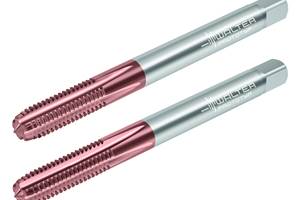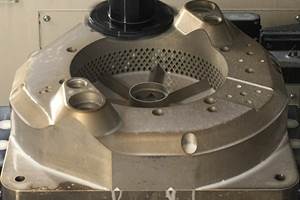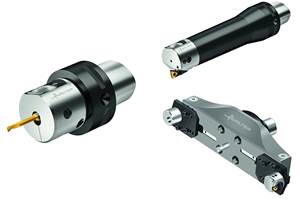Tooling Reduces 21 Minute Job To 9 Minutes
Shop leadership was looking for a way to reduce the time it took to complete a very difficult boring job. The job took 21 minutes per part to complete with multiple roughing and finishing processes. It required 10 minutes of hone time.
Hommer Tool and Manufacturing Company (Arlington Heights, Illinois) employs about 40 people. Its equipment includes six CNC lathes, one CNC machining center, grinding, honing and wire EDM equipment. The company emphasizes precision processes and quality workmanship. It accepts mostly shorter run jobs with tight tolerances, many for the injection molding industry.
James "JR" Hommer, vice president, was looking for a way to reduce the time it took to complete a very difficult boring job. The job took 21 minutes per part to complete with multiple roughing and finishing processes. It required 10 minutes of hone time.
The material used for the cylindrical workpiece was Inconel, a strong, resilient aerospace alloy that can be tough to machine. Hommer Tool, a job shop specializing in close tolerance round tooling, had to remove 0.060 inch of material and keep tolerance within ± 0.0005 inch.
The diameter of the bore was 1.290 inches and the depth was 9 inches—a diameter to length ratio that would exceed any published standards, according to Mr. Hommer.
Application engineer Jeff Stone of KPT/Kaiser Precision Tooling, Inc. (Elk Grove Village, Illinois), and distributor Tom Senger, West Side Industrial Supply (South Elgin, Illinois), came up with a possible solution. They proposed dispensing with the honing operation and reducing the multiple roughing and finishing processes to a single, two-sided operation on a lathe using KPT/Kaiser's 10.315.301 twin cutter roughing head.
KPT/Kaiser twin cutters have not often been considered for applications on lathes, and Mr. Hommer had to be persuaded that the same tool would do both roughing and finishing within the tight tolerance. "No one had samples to prove the process," he says. "It was putting a lot of risk on me." On the other hand, none of Hommer's other tooling suppliers had a competitive bid for the job, so Mr. Hommer decided to take the chance.
Everyone was pleased with the results. "It cut a 21-minute job to 9 minutes" Mr. Hommer says. Considering that Hommer's contract called for producing 2,000 of these pieces for a military application, saving 12 minutes per piece meant significant cost reduction.
"We don't like to talk specific dollars, but we can say that Kaiser tooling helped to make this a profitable contract," Mr. Hommer says. "We used a carbide bar with coolant through," says Mr. Stone. "The bar length was 13.8 inches, long enough to cut a bore 12.1 inches deep. This is an in-stock item at KPT/Kaiser, where our competition was quoting specials."
"Running a twin cutter on a lathe requires much closer attention to setup detail than in rotating tool applications," Mr. Stone adds. "We have to align the inserts parallel to the ways of the machine. In this case, we were using one insert for roughing and the other side for finishing, making two operations with the same tool. The cutting edges of the inserts have to be positioned precisely on the centerline and the length of the tool must be precisely parallel to the centerline of the bore to be machined."
Hommer used a 11.654.968 TiAlN-coated insert. They roughed out 0.040 inch at 100 SFM/0.003 IPR and finished at 200 SFM/1.8 IPR, removing 0.020 inch of material.
"‘Never been done' has never been a term in our vocabulary," says Mr. Hommer. "We welcome new manufacturing challenges!"
Related Content
Walter Offers New Solid-Carbide Taps for Blind-Hole Machining
Walter’s TC388 Supreme and TC389 Supreme feature patent-pending cutting geometries that fully shear off the root of the chip when reversing, thus minimizing torque peaks.
Read More10 Ways Additive Manufacturing and Machining Go Together and Affect One Another
Forget “additive versus subtractive.” Machining and metal additive manufacturing are interconnected, and enhance the possibilities for one another. Here is a look at just some of the ways additive and machining interrelate right now.
Read MoreWalter Extends Line of Precision Boring Tools
The new boring tools employ modular components such as cartridge holders and extensions, which are matched to the system, utilize an extensive range of indexable inserts suited for precision boring and can be used for all material groups.
Read MoreChoosing Your Carbide Grade: A Guide
Without an international standard for designating carbide grades or application ranges, users must rely on relative judgments and background knowledge for success.
Read MoreRead Next
3 Mistakes That Cause CNC Programs to Fail
Despite enhancements to manufacturing technology, there are still issues today that can cause programs to fail. These failures can cause lost time, scrapped parts, damaged machines and even injured operators.
Read MoreThe Cut Scene: The Finer Details of Large-Format Machining
Small details and features can have an outsized impact on large parts, such as Barbco’s collapsible utility drill head.
Read More



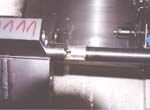
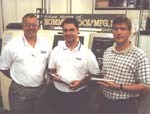











.png;maxWidth=300;quality=90)



